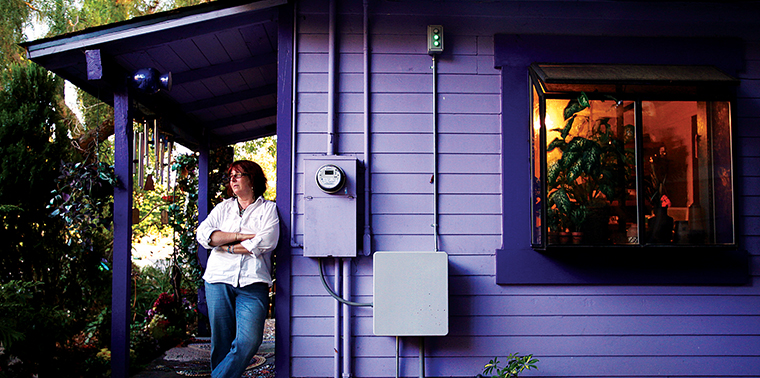September 5, 2017 — When Jane Horton bought her dream 800-square-foot farmhouse in 1975, she thought little of the semiconductor manufacturing plant across the street. Even after the company’s buildings were demolished and a chain-link fence went up around the campus, she still had no knowledge of the toxic dangers lurking beneath her feet — let alone of the fact that they were invading her home.
It wasn’t until the early 2000s that Horton and other residents of Mountain View, California, heard about the underground plume of trichloroethylene, or TCE — a cancer-causing liquid used at the facility to clean silicon chips. Horton learned that vapors from the TCE were seeping up from the groundwater and soil into local buildings. When investigators tested the air inside her family’s house in 2004, they found concentrations of TCE exceeded a site-specific threshold set by the U.S. Environmental Protection Agency. And that was after approximately 75 percent of the contamination had already been cleaned up.

“Are my kids going to die?” Jane Horton wondered after officials discovered TCE vapors invading her home. Photo courtesy of Michelle Le/Mountain View Voice
“We’d been over the plume the whole time,” says Horton, whose youngest son was still in elementary school when the vapors were discovered. “I can remember being so outraged that everything took so long. I’m wondering: Are my kids going to get cancer? Are my kids going to die? How am I going to be?” A venting system the EPA installed in her cellar now sucks toxic gases up from the soil, sending them through pipes and out a rooftop stack into the air, where they would be quickly diluted to acceptable levels. Periodic monitoring by the agency has since shown that the TCE levels at the house are safe.
“It took them about a year to get the system working right,” Horton says. “It will be in the house until the house is no longer there.”
Meanwhile, similar stories of toxic vapors intruding into buildings continue to surface around the country — from a mobile home park near San Diego to sites throughout Minnesota.
The implicated contaminants — most notoriously chlorinated solvents, such as TCE and tetrachloroethylene (known as perc), as well as benzene — can migrate through soil and groundwater from where they have seeped into the earth from a leak or a spill. Common sources include dry cleaners, gas stations, auto repair shops, military bases and industrial sites, even those whose doors closed decades ago.
While exposure to high levels of these vapors can cause immediate effects, such as irritation and fatigue, breathing small amounts over a period of time is more concerning, according to Phil Landrigan, a pediatrician and epidemiologist at the Mount Sinai School of Medicine. “Babies and small children can especially be damaged by very low concentrations of some of these materials,” he says. Long-term exposure to TCE, perc or benzene is known or suspected to raise the risk of certain cancers and other health effects, although it still remains unclear if intruding vapors reach high enough concentrations to pose a significant threat to human health. Research also hints at a link between a woman’s exposure to TCE during the first trimester of pregnancy and fetal heart malformations — a finding that has added considerable controversy and complication in addressing vapor intrusion.
Soil bacteria readily biodegrade benzene and other hydrocarbons into relatively benign products such as water and carbon dioxide, making these contaminants a lesser concern. The breakdown of chlorinated solvents, on the other hand, can be slow and generate even more toxic by-products. Perc, for example, breaks down into TCE, which in turn creates dichloroethene and vinyl chloride, a potent carcinogen that is particularly persistent and mobile in the environment.

Drawn by air movement above ground, toxic fumes can move from contaminated soils and water into homes and other buildings. Illustration by Sean Quinn
Experts, including EPA officials, are not able to estimate the full scale of vapor intrusion. But it is likely extensive. Amy Graham, an EPA spokesperson, noted 91 existing Superfund sites where unacceptable human health risks associated with vapor intrusion triggered mitigation. Nearly 4,000 other sites are regulated under the Resource Conservation and Recovery Act, of which the EPA previously estimated a quarter likely have some vapor intrusion.
The EPA does not track the occurrence of vapor intrusion for the estimated more than 450,000 brownfields, another category of contaminated properties, in the U.S. What’s more, in 2002, the U.S. General Accounting Office suggested 200,000 underground storage tanks then in operation were not being managed properly and so could be at elevated risk for leaking. And an estimated 75 percent of the more than 36,000 dry-cleaning facilities currently operating in the U.S. have discharged solvents into the environment. “As more and more sampling is done, more and more vapor intrusion is found across the country,” says Lenny Siegel, executive director for the nonprofit Center for Public Environmental Oversight.
“The thing about vapor intrusion is that people are exposed in their homes, their workplaces, their places of worship, their schools without their knowledge and against their will to dangerous chemicals,” adds Siegel. “That’s intrusion.”
The movement of toxic vapors into buildings, while generally under the radar of public attention, is attracting increased scrutiny from environmental health experts, advocates and agencies. The EPA significantly lowered the level of TCE exposure it deemed safe when it published a final version of its toxicity assessment in 2011. In 2015, the EPA released voluntary guidance for state and tribal agencies on evaluating and addressing vapor intrusion. And in May of this year, the agency added vapor intrusion to the criteria used in determining whether a site qualifies for Superfund status. Still, no consensus yet exists across the country on how to deal with the issue.
Vacuuming Vapors
Regulators, as well as many scientists, didn’t take much notice of vapor intrusion until the 2000s. At that time, awareness had grown about the hazards of radon, a radioactive, carcinogenic gas that comes from the natural breakdown of uranium or thorium in the ground and was found to be leaking into basements. People had begun to connect the dots.
“The radon problem is essentially the same phenomenon, except it has a source that is natural rather than manmade,” explains Eric Suuberg, co-director of the Superfund Basic Research Program at Brown University.
As with radon, the average person is not likely to detect vapor intrusion. “You can’t smell it, you can’t see it,” he says. “You need sophisticated instrumentation to get to the kinds of low concentrations that are involved.”
Both radon and manmade vapors can enter a building in much the same way that dirt is drawn into a vacuum cleaner. Suction is created when air moves from areas of high pressure to comparatively low pressure. So just as the suction created at the floor by a vacuum cleaner pulls in small particles and traps them inside a bag or compartment, air movement can draw toxic vapors into a house through cracks or other openings in the foundation.
“It’s basic physics,” says William Suk, director of the Superfund Research Program at the National Institute of Environmental Health Sciences. “Gases have to go somewhere, and they will find a way to go up.”
In North Canton, Ohio, an even more direct connection between vacuums and vapor intrusion has emerged. The Hoover Company began making vacuum cleaners in the town during the early 1900s. Over the following decades, manufacturing led to releases of TCE and perc.
Today, redevelopment of the approximately 85-acre (34-hectare) Hoover site has prompted increased oversight by the EPA, including efforts to assess and address the historic contamination on and off the site.

In 2016, officials found unacceptably high levels of TCE in Community Christian Church of Canton Ohio, which houses a Sunday school and preschool. Photo courtesy of Chuck Osborne
Community Christian Church abuts the former factory. William Henry “Boss” Hoover, the company’s founder, actually served as a president, preacher and teacher at the church more than a century ago. In 2016, when EPA contractors tested the air inside the church, which houses a Sunday school and a preschool on its lower levels, they found unacceptably high levels of TCE.
“We didn’t know we had a problem until they told us we had a problem,” says Jack Hartley, who serves as treasurer for the church.
Hartley suggests that “not a lot of people” at the church know about the vapor intrusion, but adds that the discovery “wasn’t that alarming.” The bigger concern for the congregation at the time, he says, was keeping the sanctuary cool. The church needed to replace a 40-year-old air-conditioning unit, which they did with financial help from a Hoover trust. The Hoover property developer, meanwhile, paid for the installation of a mitigation system inside the church, and TCE concentrations subsequently dropped.
“No one here wants to acknowledge or talk about it,” says Chuck Osborne, a local resident and activist. “The name Hoover here is revered. It’s hard for people to imagine that they left us a toxic contaminated mess.”
Hunting Hazards
Horton, the Mountain View farmhouse owner, recognizes the conflicting social pressures, too. After the mitigation system was installed in her home, some parents would not let their kids come over to play with her sons. “We probably had the cleanest air in Mountain View,” she says, noting that many families remain in the dark about the air quality in their own homes because they’re concerned that having their air tested would lower property values.
Even with the cooperation of homeowners, regulators, polluters and other stakeholders, the challenges don’t cease. Difficulties remain in knowing where, when and how to look.
“You can’t just willy-nilly drill a well, pull water up from any random depth and say that characterizes the problem.” – Eric SuubergSome states use the groundwater concentration of a contaminant to determine whether — and where — to investigate for potential vapor intrusion. But a plume doesn’t necessarily stay in place. It might drift north, south, east or west from the source. Sewer lines can send vapors even longer distances. Companies have been known to empty chemicals directly into sewers, and cracks in aged lines can pick up vapors in contaminated areas. Concentrations at various depths can also change across seasons — or even days. A heavy rain might put a layer of relatively clean water on top of the contaminated water, explains Suuberg. “You can’t just willy-nilly drill a well, pull water up from any random depth and say that characterizes the problem,” he says.
If a groundwater sample exceeds the screening level — a value that can vary by state — the next step is often to test for the gas in the soil just above the water table. But again, that depth can fluctuate. If the soil-gas concentration surpasses another threshold, investigators will sample air inside the building. Some investigators bypass soil-gas testing and go immediately indoors.
This step can be tricky, too. Consumer products, such as paints, gasoline and dry-cleaned clothes, can emit the same vapors and so can obscure results. Further complicating matters, concentrations of contaminants in indoor air can swing by an order of magnitude or more, depending on air pressure, temperature and circulation, explains Laurent Levy, a senior project manager at Gradient, an environmental and risks sciences consulting firm. Taking one 24-hour sample, as is classically done, may miss variations across days and months. Developers are looking into affordable continuous monitoring tools. The EPA now also recommends multiple rounds of sampling.
The indoor air concentration that will trigger a response varies widely by state — despite the finalized 267-page federal guidance and updated toxicity assessments for TCE and perc. When a specified level is reached, even just how to respond is not always clear. However, it usually involves some form of ongoing monitoring or mitigation similar to systems installed at the Hortons’ and Community Christian Church.
From Action to Prevention
In the face of regional inconsistencies, as well as pushback from litigation-weary companies and fearful families, Levy suggests the need to “switch from reaction to prevention.” A tax credit, he says, might help incentivize preemptive installation of mitigation systems in circumstances where there is potential for vapor intrusion — avoiding the need to spend time and money on an investigation. The EPA’s Region 9 now requires that new buildings constructed over the Mountain View Superfund site include vapor intrusion control measures.
Still, he says, it’s important to remember that vapor mitigation measures do not make the problem go away. “You’re just cutting the pathway,” says Levy. “You still need to go back and address the source.”
Fending off future contamination that could lead to more preventable cases of vapor intrusion is also critical, experts say.Mountain View got a head start with cleanup because drinking water regulations had already prompted the EPA to grant Superfund status. The addition in May 2017 of vapor intrusion to the qualifying criteria for the National Priorities List, the hazardous waste sites eligible for long-term cleanup under the Superfund program, may lead to the remediation of more sources.
Fending off future contamination that could lead to more preventable cases of vapor intrusion is also critical, experts say. Updated regulations detail the proper use and maintenance of underground storage tanks, which could help prevent leaks. And the EPA, during the final months of the Obama administration, proposed bans for certain uses of TCE. But while people continue employing the culprit chemicals, fully stopping the unwelcome intruders remains unlikely.
“We’re still using gasoline. We’re still using chlorinated solvents. TCE is still valued as a good gun cleaner,” says Suuberg. “These are not, in any sense, outlawed chemicals.”
Beyond keeping vapor-emitting products out of their home and complying with vapor intrusion testing and mitigation, individuals can further lower their risks with some due diligence.
“Just as we advise people to be wary of lead paint and asbestos when moving into a new house or apartment, people also need to look at the surroundings,” says Mount Sinai’s Landrigan. “Are they buying a home next to where there used to be a dry-cleaning shop?” ![]()
Ensia shares solutions-focused stories free of charge through our online magazine and partner media. That means audiences around the world have ready access to stories that can — and do — help them shape a better future. If you value our work, please show your support today.
Yes, I'll support Ensia!

Rick Bird, physician of internal, occupational and environmental
Thanks for the heads up!